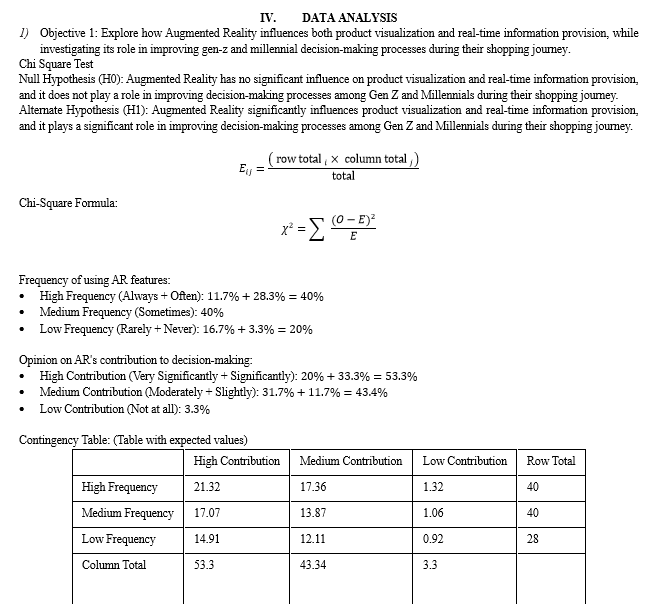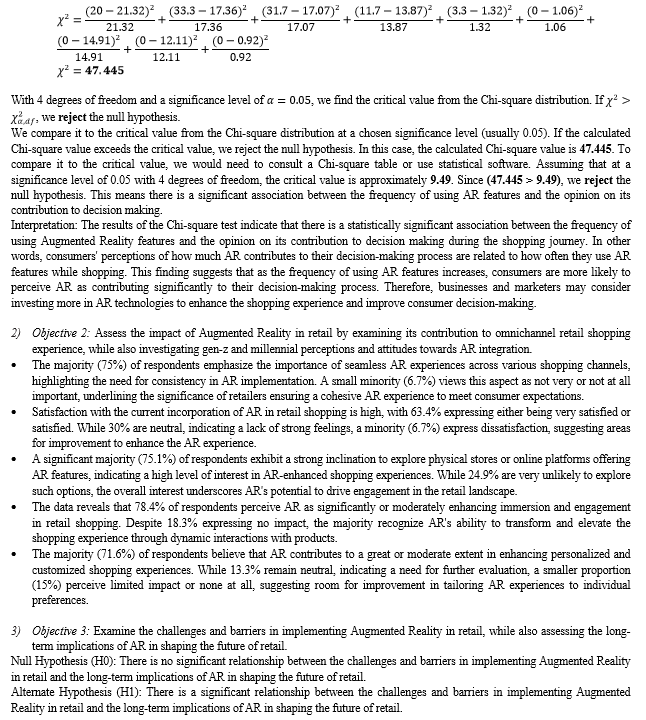Ijraset Journal For Research in Applied Science and Engineering Technology
- Home / Ijraset
- On This Page
- Abstract
- Introduction
- Conclusion
- References
- Copyright
The Role of Augmented Reality in Enhancing the Retail Shopping Experience
Authors: Ritvik Gupta
DOI Link: https://doi.org/10.22214/ijraset.2024.61081
Certificate: View Certificate
Abstract
Augmented Reality (AR) technology has emerged as a transformative tool with the potential to revolutionize the retail industry. This paper delves into the role of AR in enhancing the retail shopping experience by examining its impact on traditional retail environments, customer engagement, and purchasing behavior. Through a comprehensive analysis of current applications and case studies, this paper highlights the ways in which AR is reshaping the retail landscape. Moreover, it discusses the challenges facing widespread adoption of AR in retail and explores future prospects for this technology.
Introduction
I. INTRODUCTION
Augmented reality (AR) integrates digital elements into the real world, enhancing user experiences through visuals, audio, and text. In retail, AR is revolutionizing customer interactions by merging virtual and physical environments. Users access AR through smartphones, engaging with virtual objects and information overlaid on their surroundings.
AR in retail offers diverse applications, from virtual product trials to interactive marketing campaigns. It provides real-time product information, allowing customers to scan items for specs, reviews, and deals. Retail brands use AR for captivating promotions, transforming advertisements into engaging experiences. Virtual shopping assistants powered by AR guide customers through their purchasing journey, offering personalized recommendations and advice.
Overall, AR in retail has evolved into a valuable tool for enhancing the shopping experience, influencing customer behavior, and providing added value through immersive interactions and personalized services.
A. Benefits
Augmented reality (AR) offers numerous benefits in retail, including providing precise product information, reducing decision-making time, and lowering customer returns by enabling virtual product trials. It enhances consumer satisfaction, increases sales, and improves product visualization by allowing customers to see how items fit or appear in their environment. AR also enhances product information presentation, facilitates real-time price comparison, and promotes more interactions during purchasing by offering immersive experiences and interactivity. Furthermore, AR can enhance after-sales support by improving training effectiveness and enabling virtual product demonstrations for customer service representatives, ultimately leading to a more informed and efficient customer service experience.
B. Augmented Reality Applications
- Product Visualization: Augmented reality (AR) allows users to visualize products in their own environment, revolutionizing the purchasing process by offering a realistic view from home. Toyota's AR program enables customers to customize cars effortlessly, enhancing engagement and convenience in automotive accessory sh
- Immersive "Try Before You Buy" Experience: Virtual try-on features, like those offered by Warby Parker and BMW, enable customers to preview products virtually. This AR-driven strategy not only boosts customer satisfaction but also reduces returns for misfitting products.
- Personalization and Customization: AR enables customers to view and customize products according to their preferences, whether it's trying on sunglasses or customizing a vehicle. This level of personalization enhances the shopping experience and increases engagement.
- Gamification in In-Store Shopping: Integrating AR game components into retail experiences, as seen in Tesco's app, can engage customers, particularly younger ones accustomed to gamified concepts. These gamified experiences incentivize interactions and enhance the overall shopping journey.
- Virtual Navigation: AR navigation systems help customers navigate large stores, providing real-time details about physical goods on their mobile devices. This enhances convenience and improves the overall shopping experience by making it easier for customers to locate items.
C. Challenges
- Technical Limitations: AR faces significant technical hurdles due to demanding hardware requirements, including high processing power and battery life, making it inaccessible for many users. Developing reliable AR software involves challenges in accurate tracking, object identification, and real-time rendering, putting strain on devices and developers alike.
- Privacy and Security Concerns: The use of AR in retail raises privacy and security issues, with data collection and constant connectivity posing risks to user privacy. Retailers must implement strong data security measures, obtain consent, and disclose information about data collection and usage to address concerns around personal data handling.
- Data Protection Challenges: AR applications gather extensive personal data, requiring robust data protection mechanisms to safeguard user privacy, including encryption standards and transparent data gathering practices. By prioritizing user trust and implementing secure data handling procedures, retailers can ensure a safe environment for AR shopping experiences.
D. Future
- Enhanced Product Visualization: Augmented reality revolutionizes product visualization by allowing customers to virtually try on clothes, preview furniture in their homes, or see gadgets in real-world settings, enabling better-informed purchase decisions and reducing buyer regret.
- Improved Customer Engagement: Retailers can differentiate themselves by offering unique AR-powered experiences like virtual makeup trials or personalized automobile customization, enhancing customer engagement and increasing conversion rates.
- Personalized Shopping Experiences: AR enables retailers to provide personalized shopping journeys and product recommendations based on individual customer preferences, leading to increased sales, customer satisfaction, and loyalty.
- Reduced Return Rates: Augmented reality minimizes return rates by allowing customers to virtually see and test products before purchase, ensuring better alignment between expectations and reality. For instance, furniture retailers can enable digital room planning to ensure size and design compatibility, resulting in more confident purchases and fewer returns. Apologies for the oversight. Here are the remaining two points:
- Brick-and-Mortar Transformation: Augmented reality aids traditional businesses in adapting to the digital age by enhancing physical stores with interactive AR experiences such as product demos and information overlays. This fusion of digital and physical elements elevates the entire shopping experience, making it more engaging and memorable for customers.
- Increased Online and Offline Integration: Augmented reality technologies facilitate the integration of online and offline retail experiences, allowing customers to engage with AR-powered applications both in-store and at home. This seamless integration strengthens the omnichannel strategy, encouraging customers to interact with the brand across various touchpoints for enhanced and consistent experiences.
II. LITERATURE REVIEW
"Pusuluru Sai's (2023) 'Interactive Shopping Using Augmented Reality' explored AR's transformative potential in retail, highlighting its immersive elements for enhancing the shopping experience. The study discussed AR's ability to revolutionize retail by enabling customers to view products in real settings, emphasizing benefits like try-on features and product visualization. It outlined the current state of AR in retail while acknowledging associated challenges."
"In 'The Impact of AR Technology on Consumers' Purchasing Decisions,' authored by Ran Liu (2024), AR's potential in improving communication between customers and merchants was explored, discussing features like virtual changing rooms. It addressed challenges like cost and privacy concerns and reviewed literature on AR's impact on customer experience and purchase intent, stressing the need to overcome market acceptance and technological limitations."
"Tingting Zhang (2019) investigated VTO technology's impact on online consumers' decision-making, integrating risk, hedonic, and utilitarian viewpoints through a web-based survey. Findings highlighted its significant influence on purchase propensity, analyzed using advanced PLS techniques."
"Trivedi (2023) explored Gen Z's adoption of AR in online shopping, revealing significant impacts on attitudes toward VTOs and purchase intentions. Insights from a web-based survey in India underscored the importance of PLS techniques for understanding complex consumer behavior."
"Andrey A. Dashkov (2022) discussed AR systems' potential in retail automation, addressing current issues and improving work performance. Comparison studies provided insights into optimizing retail processes and interactions with salesroom staff."
"Edmanuel Cruz (2019) introduced an AR and deep learning system to enhance navigation in large retail outlets, providing precise area identification and useful information for users. He highlighted the potential of deep learning and AR to improve user experience in retail applications."
"Shuo-Yun (2022) evaluated the impact of AR applications on consumer decision-making and purchase intention, addressing flow state hindrances and recommending improvements for AR try-on services. He offered insights for enhancing customer experience in retail outlets."
"Samir A. El-Seoud Islam (2019) analyzed the implementation of AR in fashion retail stores, examining consumer behavior regarding the acceptance of AR applications. He emphasized the need for further research on challenges and disadvantages in fashion retail."
"Ika Asti Astuti (2023) introduced an AR face-tracking tool for online eyewear shopping, enhancing the interactive purchase experience and compatibility across various platforms. She discussed the integration of AR into e-commerce to improve customer interaction and decision-making."
"Hammami (2023) explored how AR can enhance the online buying experience for apparel brands, emphasizing its role in creating energetic and interactive purchasing experiences."
III. RESEARCH METHODOLOGY
A. Research Objectives
- Explore how Augmented Reality influences both product visualization and real-time information provision, while investigating its role in improving gen-z and millennial decision-making processes during their shopping journey.
- Assess the impact of Augmented Reality in retail by examining its contribution to omnichannel retail shopping experience, while also investigating gen-z and millennial perceptions and attitudes towards AR integration.
- Examine the challenges and barriers in implementing Augmented Reality in retail, while also assessing the long-term implications of AR in shaping the future of retail.
B. Research Design
The research design included a cross-sectional survey method, grouping data at a particular juncture to assess the current results on the role of augmented reality in enhancing the retail shopping experience impacting consumer attitude and perception.
C. Sample Size
The sample size was around 60 consumers. The perfect sample population had the following characteristics. It involved those individuals who frequently used augmented reality applications such as virtual try-ons and product visualization to strengthen their overall retail shopping experience.
D. Sample Technique
Both convenience and stratified sampling techniques were employed in the research, offering unique advantages. Convenience sampling facilitated easy participant connection, while stratified sampling enhanced representation of diverse groups within the population. This dual approach helped navigate practical challenges while ensuring inclusivity, increasing the likelihood of broad perspectives in research findings.
E. Type of Questionnaire
The research paper utilized a structured questionnaire comprising multiple-choice and Likert scale questions. Multiple-choice questions offered a structured understanding of experiences and preferences, while Likert scale questions measured opinions quantitatively. This combination allowed for a comprehensive exploration of both qualitative insights and quantitative trends.



Conclusion
Data Collection Technique In this research, a unified survey approach was used, employing multiple-choice and Likert scale questions to explore how augmented reality impacted the retail experience for Gen Z and Millennials. The survey was distributed via WhatsApp, Instagram, and email to efficiently reach the target group, providing both qualitative and quantitative data. A combination of stratified and convenience sampling techniques ensured a diverse and representative sample, addressing practical challenges while ensuring inclusivity.
References
[1] Andrey A. Dashkov, D. V. (2022). Use of Augmented Reality (AR) Technologies in Retail. [2] BAÑOS, I. A. (2021). Consumer’s Perceptions and Attitudes on Augmented Reality in Online Retail. [3] Edmanuel Cruz, S. O.-D. (2019). An augmented reality application for improving shopping experience in large retail stores. [4] Hammami, H. (2023). The Role of Augmented Reality in The Online Shopping Experience: How Can Clothing Brands Use Mobile Augmented Reality Applications to Offer a More Immersive Shopping Experience to Their Customers. [5] Ika Asti Astuti, M. N. (2023). Development of Augmented Reality Face Tracking Features on Glasses E-Commerce Websites. [6] Pusuluru Sai, L. R. (2023). Interactive Shopping Using Augmented Reality. [7] Ran Liu, B. B. (2024). The Impact of Augmented Reality (AR) Technology on Consumers\' Purchasing Decision Processes. [8] Robert Zimmermann, D. M. (2022). Enhancing brick-and-mortar store shopping experience with an augmented reality shopping assistant application using personalized recommendations and explainable artificial intelligence Enhancing brick-and- mortar shopping experience. [9] Samir A. El-SeoudIslam, I. T.-E. (2019). An Android Augmented Reality Application for Retail Fashion Shopping. [10] Shuo-Yun, Y. ,. (2022). Exploring the role of flow in. [11] Syed Ali Fathima S J, s. S. (2019). ADVENT OF AUGMENTED REALITY EXPERIENCE IN RETAIL AND ONLINE SHOPPING AND ITS INFLUENCING SIGNIFICANCE IN FUTURE. [12] Syed Shah Alam, S. S.-Y.-H. (2021). Factors Affecting Augmented Reality Adoption in the Retail Industry. [13] Tingting Zhang, W. Y. (2019). The role of virtual try-on technology in online purchase decision from consumers’ aspect. [14] Trivedi, T. (2023). Generation Z Inclined Toward Immersive Shopping Experiences: AR Virtual Try-On in Online Retail in India. [15] Virginie Lavoye, J. M. (2021). Consumer behavior with augmented reality in retail: a review and research agenda.
Copyright
Copyright © 2024 Ritvik Gupta. This is an open access article distributed under the Creative Commons Attribution License, which permits unrestricted use, distribution, and reproduction in any medium, provided the original work is properly cited.

Download Paper
Paper Id : IJRASET61081
Publish Date : 2024-04-26
ISSN : 2321-9653
Publisher Name : IJRASET
DOI Link : Click Here
 Submit Paper Online
Submit Paper Online

